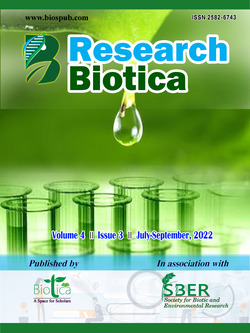
The Physio-Morphic Characters of Different Okra Germplasm and their Relationship with the Population Dynamics of Okra Leafhopper, Amrasca biguttula biguttula (Ishida)
K.P. Manju*
Dept. of Agricultural Entomology, Krishi Vigyan Kendra, Kannur, Kerala Agricultural University, Kerala (670 142), India
DOI: https://doi.org/10.54083/ResBio/4.3.2022/119-123
Keywords: Accessions, Amrasca biguttula biguttula, Okra germplasm, Trichome density
Abstract
The reactions of twenty five (25) accessions of okra were evaluated under field conditions against Leafhopper, Amrasca biguttula biguttula. The experiment was conducted at NBPGR, regional station Hyderabad. Among twenty five germplasm (25) screened against the okra leafhopper, IC344596 recorded significantly lowest leafhopper population which was followed by RJR-124, PSRJ12952, NIC 9402 and IC433667. PSRJ 13040 and RJR-193 recorded high population of leafhopper. RJR-124, PSRJ12952 and IC344596 recorded significantly highest number of trichomes of 57.00, 47.67 and 42.33 trichomes m-2, respectively. RJR-193 and PSRJ 13040 recorded significantly less number of trichomes (10.33 m-2). Correlation between okra leafhopper and the various yield and growth parameters of okra accessions revealed highly significant and negative correlation for yield, number of pods and significant positive correlation with plant height while non-significant correlation recorded with pod length.
Downloads
not found
Reference
Ahmad, N., Sarwar, M., 2013. The cotton bollworms: Their survey, detection and management through pheromones: a review. Research and Reviews: Journal of Agriculture and Allied Sciences 2(3), 5-8.
Ahmed, G., Arif, M.J., Sanpal, M.R.Z., 2005. Population fluctuation of jassid, Amrasca devastans (Dist.) in cotton through morphophysical plant traits. Caderno de Pesquisa Ser Bio, Santa Cruz, Sul 17(1), 71-79.
Ali, S., Khan, M., Rasheed, A.H.S., Iftikhar, Y., 2012. Performance of different okra varieties against pests and diseases during different seasons. Journal of Agricultural Biology 7, 142-144.
Arora, S., Singh, D.K., 2004. Residues of insecticides from IPM and non-IPM fields of okra and brinjal. Pesticide Research Journal 16(2), 68-70.
Atwal, A.S., Singh, B., 1990. Pest population and assessment of crop losses. ICAR Publication, Indian council of Agricultural Research, New Delhi. p. 265.
Halder, J., Sanwal, S.K., Deb, D., Rai, A.B., Singh, B., 2016. Mechanisms of physical and biochemical basis of resistance against leafhopper (Amrasca biguttula biguttula) in different okra (Abelmoschus esculentus) genotypes. Indian Journal of Agricultural Sciences 86(4), 481-484.
Iqbal, J., Hasan, M., Ashfaq, M., Sahi, S.T., Ali, A., 2011. Studies on correlation of Amrasca biguttula biguttula (Ishida) population with physio-morphic characters of okra, Abelmoschus esculentus (L.) Moench. Pakistan Journal of Zoology 43(1), 141-146.
Khan, M.M.H., Kundu, R., Alam, M.Z., 2000. Impact of trichome density ion the infestation of Aphis gossyii Glover and incidence of virus disease in ashgourd [Beninca sahispida (Thunb.) Cogn.]. International Journal of Pest Management 46, 201-204.
Kumari, A., Madan, V.K., Kumar, R., Kathpal, T.S., 2002. Monitoring of seasonal vegetables for pesticide residues. Environment Monitoring and Assessment 74, 263-270.
Nagar, J., Khinchi, S.K., Kumawat, K.C., Sharma, A., 2017. Screening different varieties of okra [Abelmoschus esculentus (L.) Moench] against sucking insect pests. Journal of Pharmacognosy and Phytochemistry 6(3), 30-34.
Murugesan, N., Kavitha, A., 2010. Host plant resistance in cotton accessions to the leafhopper, Amrasca devastans (Distant). Journal of Biopesticides 3(3), 526-533.
Naqvi, A.R., Pareek, B.L., Nanda, S., Mitharwal, B.S., 2008. Leaf morphology and biochemical studies on different varieties of brinjal in relation to major sucking insect pests. Indian Journal of Plant Protection 36, 245-248.
Sadasivam, S., Thayumanavan, B., 2003. Molecular Host Plant Resistance to Pests. Marcel Dekker Inc., New York. p. 496.
Sarwar, M., 2013. Comparing abundance of predacious and phytophagous mites (Acarina) in conjunction with resistance identification between Bt and non-Bt cotton cultivars. African Entomology 21(1), 108-118.
Singh, S., Choudhary, D.P., Sharma, H.C., Mahla, R.S., Mathur, Y.S., Ahuja, D.B., 2008. Effect of insecticidal molecules against jassid and shoot and fruit borer in okra. Indian Journal of Entomology 70, 197-199.
Ullah, S., Khan, M., Javed, H., Muhammed, A.A., 2012. Role of physio-morphic characters of different okra genotypes in relation to population of jassid, Amrasca biguttula biguttula. Journal of Agricultural Research 50(2), 217-219.
